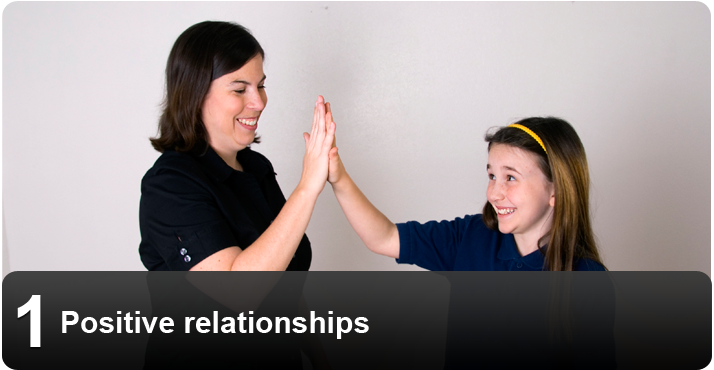“The quality of the teacher–student relationship
is the single most important factor to consider
when rethinking classroom management.”
– Patricia Sequeira Belvel
and Maya Marcia Jordan,
Rethinking Classroom Management
Positive relationships are the foundation of any classroom-based approach
to positive behaviour supports. They are the key to a safe and caring classroom
climate that invites and supports positive behaviour and skilled problem solving.
Relationships between teachers and students, among students, and between teachers
and parents are all important contributors to the classroom environment.
Teacher–student relationships
The teacher–student relationship, which is extremely important, takes time
and trust to build. Both parties must believe they are being treated with dignity
and respect, and there must be a balance between the teacher’s role as classroom
leader and his or her expression of interest in each student.
Students trust and respect teachers who establish clear behavioural expectations
and meaningful goals for learning and behaviour, and who follow up consistently.
Students know that their teacher cares about them and their individual needs
when:
- learning goals are flexible enough to accommodate differences between and
among students
- the teacher makes an effort to understand each student’s individual interests,
strengths, needs, learning preferences and personality.
Sample strategies to win over students
- Meet students at the door at the beginning of every day.
Teachers can use this strategy to informally engage students individually,
ask how they are doing, gauge their emotional state, have a brief conversation
and/or just generally make them feel welcome.
- Demonstrate a personal interest in students.
Take time in class and in the hallways or on the playground to talk with
students about their lives outside of school.
- Use students’ names positively.
Students of any age generally respond positively when a teacher smiles at
them and acknowledges them by name, especially in the hallway or on the
playground. This simple action lets students know they matter and are valued
as individuals within the school community.
- Smile, use humour and show enthusiasm.
Being able to see the lighter side and injecting humour into the day goes
a long way toward bringing students on side and diffusing potentially negative
interactions. Let students know when you are particularly enjoying the teaching
role.
Noncontingent positive reinforcement1
Stephen Covey (1989) describes noncontingent positive reinforcement as deposits
in another person’s emotional bank account. Many students, and particularly
those with behaviour disabilities, have emotional bank accounts that are close
to empty. To help these students feel more connected, teachers need to help
them build their emotional bank accounts.
Noncontingent positive reinforcement is unconditional and independent. That
is, students do not have to demonstrate specific behaviours in order to earn
it.
Noncontingent positive reinforcment can be as simple as smiling at a student
at the beginning of class, asking a student who enjoys attention to write key
words on the board during a class discussion, or sharing a snack or favourite
story as a wrap‑up to the week. Ensure that noncontingent reinforcement is
appropriate for the student’s age, interests and personal preferences.
Noncontingent reinforcement is an essential component of the teacher–student
relationship. It forms the foundation for trust and security, and provides
bonding and connections that teachers and students need. It helps students
learn that demonstrating respect and caring is a natural aspect of human interaction.
Noncontingent reinforcement:
- sets the stage for intrinsic motivation
- forms a foundation of trust
- fosters a sense of security
- creates a comfortable climate
- creates a positive association with the teacher
- increases the probability of cooperation
- models positive actions for students to emulate.
Proximity
Teachers who move around the classroom and teach from various areas and near
different students:
- send the message that they are actively involved and aware of all behaviour
in the room
- build a sense of connection with students and communicate that the teacher
is interested and available
- provide equal access to the teacher for all students
- have more opportunities to prevent negative behaviour and/or quickly deal
with problems.
Effective communication2
A number of variables affect how students perceive and respond to a teacher’s
communication. To effectively communicate expectations and requests to students:
- use polite requests rather than questions; for example, “Please start
your work”
- move close to students when giving directions—the optimal distance is approximately
one metre
- look students in the eye (considering cultural differences and not insisting
on eye contact if it makes the student uncomfortable)
- use a quiet voice
- give students at least 10 seconds to respond before repeating a request
or adding a new request
- ask only twice, and then follow through with a correction; the more often
a request is made, the less the likelihood of gaining cooperation
- make only one request at a time
- remain calm and unemotional
- make more start requests (“do”) than stop requests (“don’t”).
If the majority of requests are not start requests, consider clarifying behavioural
expectations and using stronger prompts
- verbally reinforce students when they demonstrate cooperation. This will
increase cooperation in the future.
Verbal limits3
When students are not meeting classroom behavioural expectations or following
agreed-upon procedures, describe the appropriate behaviour with a neutral body
posture and tone of voice, and without using students’ names. Verbal
limit setting has four basic forms.
- Prompt with questioning intonation: “Everyone has
their math book open?” Say this declaratively, as a prompt, not a question.
If you ask a question (“Will you open your books?”), you may
receive an answer you don’t want.
- Hint: “Everything should be off your desks.” This
statement includes everyone in the room.
- “Excuse me”: For example, to respectfully
break habits of interrupting, you could say, “Hold on for a minute,
Mel. We can’t hear you because someone else is speaking.”
- I-message: Saying “I need” or “I want”
is stronger and more assertive than the other verbal limit-setting techniques.
For example, “I need everyone to sit down.”



